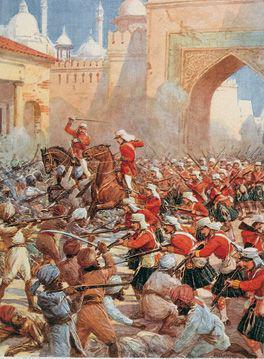India: A History. Revised and Updated (131 page)
Read India: A History. Revised and Updated Online
Authors: John Keay
Tags: #Eurasian History, #Asian History, #India, #v.5, #Amazon.com, #Retail, #History
Akbar hunting tigers, from the
Akbar-nama
, c.1590. Akbar, the third Great Mughal and the most fearless campaigner and sportsman, could neither read nor write. He was probably dyslexic.

Akbar giving an audience, from the
Akbar-nama
. The supplicant (below throne, left) presents the emperor with customary gifts including a bolt of cloth (below throne, right).

Rejoicing over the birth of Salim (Jahangir) at Fatehpur Sikri, from the
Akbar-nama
. Akbar’s gratitude for the birth of an heir resulted in the selection of Sikri as the site of his new Fatehpur (‘City of Victory’).

Taj Mahal, Agra, from across the Jamuna river, 1630–52. Dynastic pride and Islamic symbolism, not romantic heartbreak, inspired Shah Jahan’s tomb for Mumtaz Mahal who had died giving birth to their fourteenth child.

Equestrian portrait of Shah Jahan, seventeenth century. The exaltation of the Mughal sovereignty by Shah Jahan included the creation of dazzling architectural settings and the adoption of quasidivine symbols, like the Christian halo.

Ali Adil Shah II of Bijapur, Deccani miniature of
c
.1660. In architecture as in portraiture, the Deccan sultanates of Bijapur and Golconda vied with the Great Mughals. Ali Adil Shah’s riposte to the Taj was the Gol Gumbaz.

St Mary’s Anglican church, Fort St George, Madras, 1679. The English East India Company’s fort at Madras dates from 1640 and is contemporary with the Taj, but not till the 1740s did the Company espouse territorial ambitions.

Sir Henry Havelock relieving the British besieged in Lucknow in i857,from an illustration by Howard Davie of c.1910. Lucknow and Awadh evidenced the popular appeal of the Great Rebellion while steeling British resistance to the ‘Indian Mutiny’.

The Golden Temple (Hari Mandir) at Amritsar, eighteenth century and later. The holiest shrine of the Sikh faith houses the original Granth Sahib. Much restoration has been undertaken since the temple was stormed in 1984.

Statue of the Jain saint Gomateshwara, Sravana Belgola, Karnataka. The largest monolithic statue in the world, it faces the hill on which Chandragupta, founder of the Maurya empire, may have spent his declining years.

Relief medallion from the Bharhut stupa, originally in Madhya Pradesh. Such scenes from the
jataka
(birth) legends of the Buddha reveal the costumes, architecture and transport of the second century
BC

The Great Stupa (no. 1) of Sanchi, near Vidisha in Madhya Pradesh. The firstcentury
BC
stone stupa, with its balustrades and gateways, encases a brick stupa of Maurya times which enshrined a Buddhist relic.
